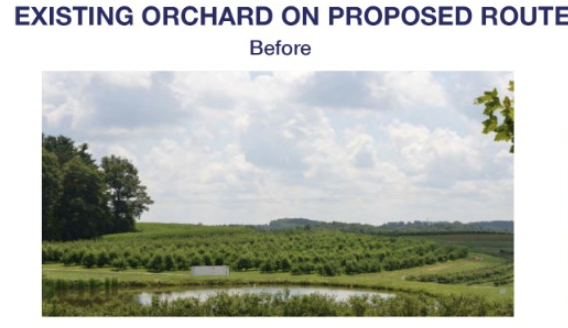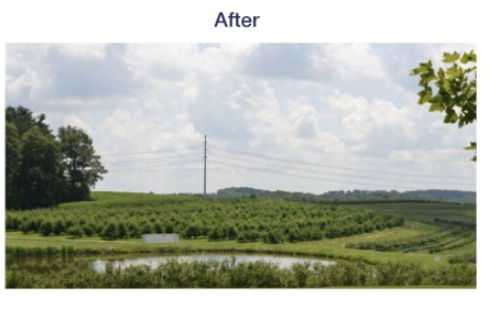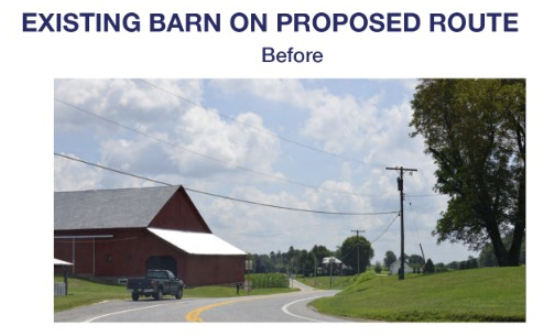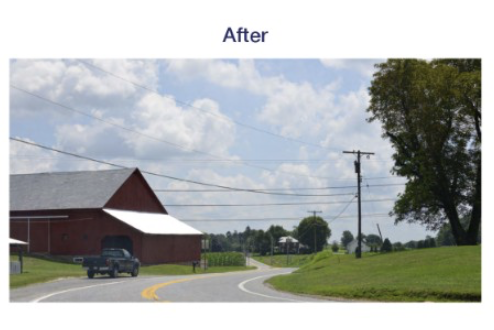For some reason, Transource sent out a "Project Update" on Friday that was akin to kicking itself in the ass. Way to go, Transource! Among the lies and half-truths were some images depicting what the project would look like if built. Even though the pictures were incredibly tiny and presented an extremely long range view, they still managed to convey the awfulness of the Transource project. I've often wondered why transmission companies do this to themselves... why do they send out photoshopped images of what their project would look like? Do they try to make these images as horrid and frightening as possible? It wouldn't be logical to create photoshopped images that look worse than reality. Instead, we can probably discern that these images use all sorts of eye-tricking perspective and shading tricks to make the new lines as unobtrusive as possible. Reality will probably be worse. Much worse. And still, Transource's photo simulations of its proposed project are a trainwreck.
How about this beautiful view?
Here's another.
Visual simulations are based on the level of design available at this time. Moderate changes in structure height and location may occur following subsequent engineering and design refinements and minor modification of the alignment.
I've heard that Transource has lots more of these photo-fibbed simulations for its entire route. Maybe you should ask your friendly neighborhood land agent to show them to you? Just so he knows why you object and perhaps will quit stopping by...
Barron Shaw from Citizens to Stop Transource took on a whole bunch of the other lies contained in Transource's email update. You can read the facts here.
I'm only going to touch on a couple more things here, the first of which is Transource's insinuation that its failure to update its project costs before PJM recalculated benefits is the fault of landowners.
Why didn’t Transource have updated costs at the time of PJM’s annual cost / benefit analysis?
Transource is following a planning and engineering process that requires a variety of data. For example, land surveys provide Transource valuable data needed for construction bids. Since winter 2017, the company has been working with landowners to access properties to be able to complete that work. The survey information is one example of information that was part of the bid package provided to potential suppliers.
Here's another I take issue with:
Landowners are encouraged to work with right-of-way agents now, during the design phase of the project, to best incorporate property owner desires into the final placement of the facilities.
And then, there's this:
Transource has not filed condemnation on anyone
The PUC process requires utilities to submit a condemnation filing during the application process. This filing includes property owners with whom the company has not yet secured a signed option to grant an easement agreement. Transource provided written notice and information explaining the process to landowners before filing the report in May.
Like this:
Regions where IEC is proposed to be built — Franklin County, Pennsylvania, and Washington and Harford counties, Maryland — are located in benefiting power zones, as identified by PJM.
And finally, Transource thinks it knows better than Pennsylvania Administrative Law Judges:
Does Pennsylvania Act 45 of 2018 apply to IEC?
Transource PA has been granted utility status by the PA PUC. Act 45 excludes “public utility facilities” from the required approval and has no effect on this project's proceedings.
And speaking of the PUC judges' opinion, take a few steps back when you read the latest "project update." Why, it reads like a rebuttal to the expert testimony recently filed by the PA Consumer Advocate, doesn't it? Is this what Transource's rebuttal testimony is going to consist of? Photoshopped awfulness and carefully worded half-truths? Good luck with that, Transource. You've got nothing.




 RSS Feed
RSS Feed